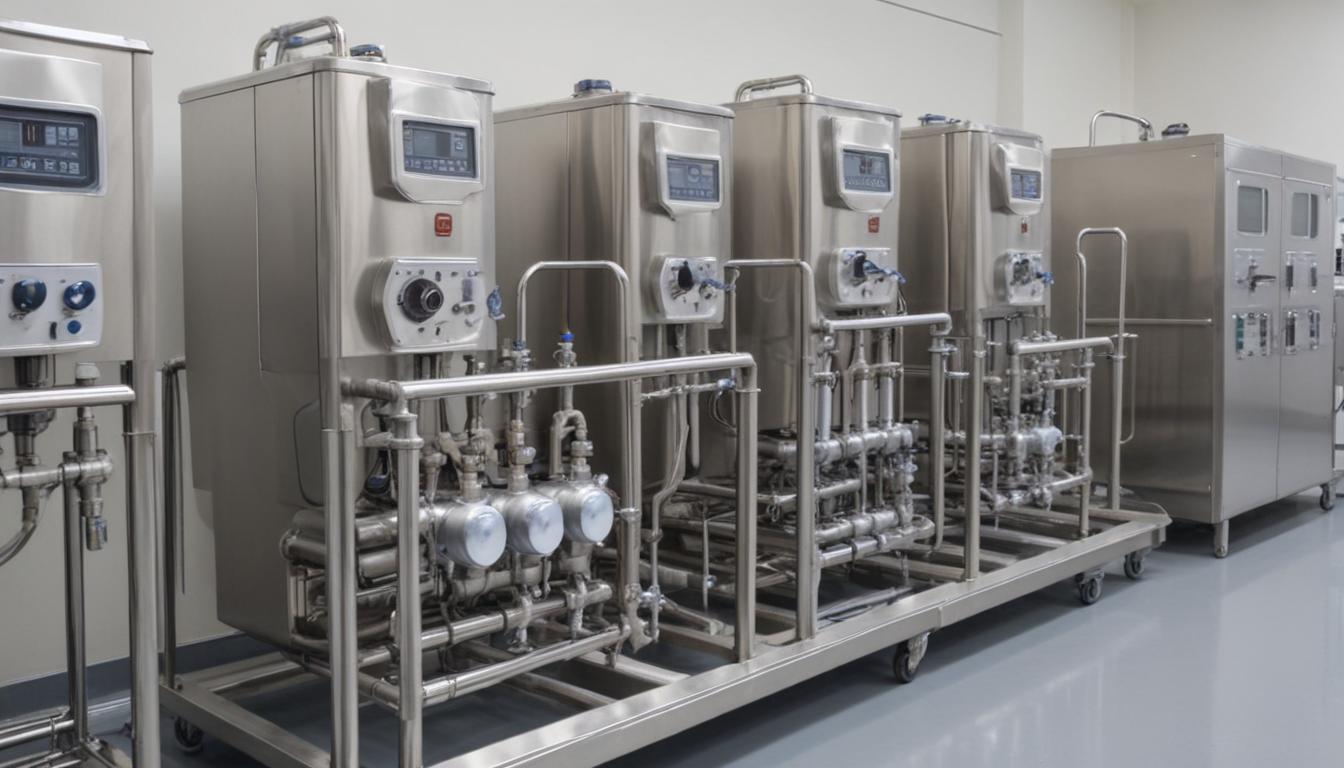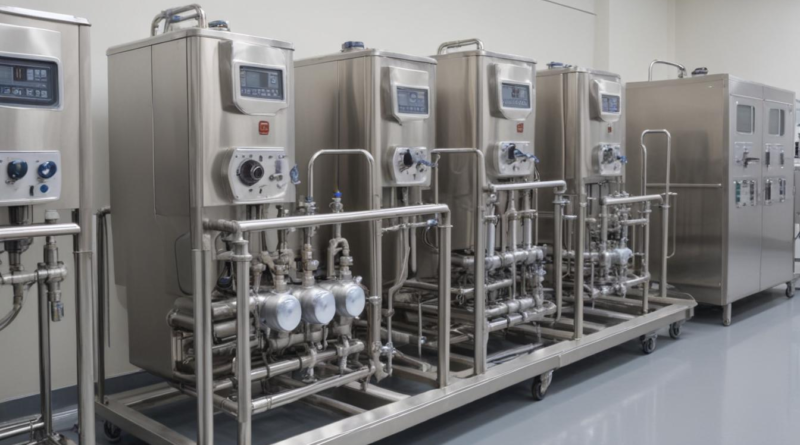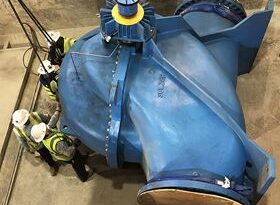pumps used in the pharmaceutical sterilization
Sterilization processes in the pharmaceutical industry require precise and reliable pumping systems to ensure the integrity and safety of products. Various pharma sterilization pumps are designed to meet these stringent requirements, each with distinct features tailored to specific applications.
- Centrifugal Pumps: These pumps utilize rotational motion to transfer fluids and are widely used due to their ability to handle large volumes at relatively low pressures. They are ideal for applications involving the circulation of liquids during steam sterilization.
- Diaphragm Pumps: Known for their excellent ability to handle corrosive and viscous fluids, diaphragm pumps are often employed in processes requiring precise flow control and high levels of cleanliness.
- Peristaltic Pumps: These pumps operate by compressing a flexible tube, making them suitable for sterile applications as the fluid only contacts the tubing, reducing contamination risks.
- Gear Pumps: Offering high pressure and consistent flow rates, gear pumps are used in applications where precise dosing and handling of viscous fluids are critical.
- Screw Pumps: These are chosen for their ability to handle shear-sensitive and particulate-laden fluids, making them suitable for specific sterilization processes that require gentle handling.
| Type of Pump | Key Features | Typical Applications |
|---|---|---|
| Centrifugal | High flow rates, low maintenance | Steam circulation, cooling systems |
| Diaphragm | Precise flow control, corrosion-resistant | Chemical sterilization, liquid handling |
| Peristaltic | Minimal contamination risk, easy to clean | Sterile fluid transfer, sensitive liquid handling |
| Gear | High pressure, consistent flow | Dosing systems, viscous fluid transfer |
| Screw | Handles shear-sensitive fluids, particulate-tolerant | Specialized sterilization processes, gentle fluid transfer |
Each type of sterilization pump offers unique advantages tailored to specific applications within the pharmaceutical sector. Selecting the appropriate pump type is crucial for optimizing sterilization efficiency, maintaining product quality, and ensuring compliance with industry standards.
Selection criteria for pharmaceutical pumps
Selecting the appropriate pumping system for pharmaceutical sterilization involves a comprehensive evaluation of several critical factors to ensure optimal performance, compliance, and product integrity. Key considerations include:
- Chemical Compatibility: The pump materials must be compatible with the sterilization agents used, such as steam, hydrogen peroxide, or other chemicals, to prevent corrosion and contamination.
- Flow Rate and Pressure Requirements: Accurate determination of the necessary flow rates and pressures is essential to maintain consistent sterilization conditions and ensure effective microbial inactivation.
- Material Construction: Pumps should be constructed from materials that meet pharmaceutical standards, typically stainless steel or other non-reactive alloys, to maintain sterility and prevent leaching of contaminants.
- Cleanability and Sterilization: The design should facilitate easy cleaning and sterilization, often incorporating features like smooth surfaces, minimal crevices, and compatibility with Clean-In-Place (CIP) and Steam-In-Place (SIP) systems.
- Reliability and Maintenance: High reliability is crucial to prevent downtime in critical sterilization processes. Pumps should offer easy access for maintenance, with readily available spare parts and support from the manufacturer.
- Regulatory Compliance: Pumps must adhere to relevant regulatory standards such as FDA, GMP, and ISO to ensure they meet the stringent requirements of the pharmaceutical industry.
- Sterile Design Features: Incorporating sterile connections, gasket-free designs, and minimal components in contact with the sterilization media helps reduce contamination risks.
- Control and Accuracy: Advanced control systems and precise flow regulation are necessary to maintain consistent sterilization parameters, which are critical for process validity and reproducibility.
- Energy Efficiency: Energy-efficient pumps contribute to lower operational costs and reduce the environmental footprint of the sterilization process.
Additionally, selecting the right pump type from the available pharma sterilization pumps is influenced by the specific applications and process requirements. A comparative analysis of different pump types based on these criteria can aid in making an informed decision:
| Selection Criterion | Importance | Impact on Pump Choice |
|---|---|---|
| Chemical Compatibility | High | Determines material selection and pump type to prevent degradation and contamination. |
| Flow Rate & Pressure | High | Influences the selection of pump capacity and control mechanisms. |
| Cleanability | Medium | Requires pumps with designs that support effective cleaning and sterilization protocols. |
| Reliability | High | Favors pumps with proven track records and robust construction to ensure uninterrupted operations. |
| Regulatory Compliance | High | Ensures that selected pumps meet necessary industry standards and certifications. |
By meticulously evaluating these selection criteria, pharmaceutical manufacturers can ensure that the chosen pumping systems not only meet the technical requirements of sterilization processes but also uphold the highest standards of product quality and regulatory compliance.
Maintenance best practices
Regular and proactive maintenance is essential to ensure the optimal performance and longevity of pharma sterilization pumps. Implementing a comprehensive maintenance strategy minimizes downtime, prevents unexpected failures, and maintains the integrity of the sterilization process. Key practices include:
- Scheduled Inspections: Conduct routine inspections to identify wear and tear, leaks, or any signs of corrosion. Regular visual and functional checks help detect issues early before they escalate into major problems.
- Cleaning Protocols: Establish strict cleaning procedures to remove residues and prevent contamination. Utilize appropriate cleaning agents compatible with pump materials and ensure thorough drying to avoid microbial growth.
- Lubrication: Maintain proper lubrication of moving parts to reduce friction and prevent excessive wear. Use manufacturer-recommended lubricants and adhere to the specified lubrication schedules.
- Component Replacement: Replace worn or damaged components promptly. Critical parts such as seals, gaskets, and bearings should be monitored regularly and substituted as needed to maintain pump efficiency and prevent leaks.
- Calibration and Testing: Periodically calibrate control systems and flow meters to ensure accurate performance. Perform performance tests to verify that pumps operate within specified parameters.
- Documentation and Records: Maintain detailed maintenance logs documenting all inspections, cleaning, lubrication, and repairs. Comprehensive records facilitate tracking of maintenance activities and compliance with regulatory requirements.
- Training and Expertise: Ensure that maintenance personnel are adequately trained in pump operation, maintenance procedures, and troubleshooting techniques. Ongoing training programs enhance the team’s ability to manage and sustain pump performance effectively.
- Preventive Maintenance Programs: Develop and implement preventive maintenance schedules based on manufacturer recommendations and historical performance data. Proactive maintenance reduces the likelihood of unexpected failures and extends the lifespan of the pumps.
Adhering to these maintenance best practices not only ensures the reliability of sterilization processes but also upholds the quality and safety standards critical in pharmaceutical applications. Additionally, leveraging technology can enhance maintenance efficiency:
| Maintenance Activity | Recommended Frequency | Purpose |
|---|---|---|
| Visual Inspections | Weekly | Identify obvious signs of damage or leaks. |
| System Cleaning | Monthly | Remove contaminants and prevent buildup. |
| Lubrication | Bi-weekly | Ensure smooth operation of moving parts. |
| Performance Testing | Quarterly | Verify operational parameters and accuracy. |
| Component Replacement | As Needed | Replace worn or defective parts to maintain functionality. |
| Calibration | Semi-annual | Ensure measurement accuracy and system reliability. |
Implementing a structured maintenance regimen supported by detailed documentation and regular training ensures that pharma sterilization pumps operate efficiently and reliably. This approach not only prolongs the life of the pumps but also supports continuous compliance with industry standards and regulatory requirements, thereby safeguarding the quality and safety of pharmaceutical products.
Regulatory compliance and standards
 Ensuring that pumping systems adhere to stringent regulatory requirements is paramount in maintaining the integrity and safety of pharmaceutical sterilization processes. Compliance with regulatory standards not only guarantees product quality but also mitigates risks associated with contamination and process failures. Key regulatory frameworks and standards that govern pharma sterilization pumps include:
Ensuring that pumping systems adhere to stringent regulatory requirements is paramount in maintaining the integrity and safety of pharmaceutical sterilization processes. Compliance with regulatory standards not only guarantees product quality but also mitigates risks associated with contamination and process failures. Key regulatory frameworks and standards that govern pharma sterilization pumps include:
- U.S. Food and Drug Administration (FDA): The FDA mandates compliance with Current Good Manufacturing Practices (cGMP) outlined in Title 21 of the Code of Federal Regulations (CFR). These regulations stipulate the standards for design, manufacturing, and maintenance of equipment used in pharmaceutical production, including sterilization pumps.
- European Medicines Agency (EMA): Similar to the FDA, the EMA enforces regulations that ensure pharmaceutical products meet high standards of quality, safety, and efficacy. Compliance with EU GMP guidelines is essential for manufacturers operating within the European market.
- International Organization for Standardization (ISO): ISO standards, such as ISO 13485 for medical devices and ISO 9001 for quality management systems, provide a framework for maintaining consistent quality in manufacturing processes, including the use of sterilization pumps.
- Pharmaceutical Inspection Co-operation Scheme (PIC/S): PIC/S offers guidance and promotes harmonization of GMP standards across different countries, facilitating international trade and ensuring uniform quality standards for pharmaceutical products.
- World Health Organization (WHO): WHO guidelines assist in establishing GMP practices, especially in regions where regulatory frameworks may be less developed. Adherence to WHO standards ensures global consistency in pharmaceutical manufacturing.
Compliance with these regulations involves several critical components:
| Compliance Aspect | Description | Relevant Standards |
|---|---|---|
| Design Qualification (DQ) | Ensuring that the pump design meets the required specifications and is suitable for its intended use. | 21 CFR Part 211, ISO 13485 |
| Installation Qualification (IQ) | Verifying that the pump is installed correctly according to manufacturer specifications and regulatory requirements. | 21 CFR Part 211, ISO 9001 |
| Operational Qualification (OQ) | Testing the pump’s functionality and performance under operational conditions. | 21 CFR Part 211, ISO 13485 |
| Performance Qualification (PQ) | Confirming that the pump consistently performs as intended in the actual production environment. | 21 CFR Part 211, ISO 9001 |
| Change Control | Managing and documenting any alterations to the pump or its operating procedures to maintain compliance. | 21 CFR Part 211, ISO 13485 |
| Documentation and Record-Keeping | Maintaining comprehensive records of all compliance activities, including validation, maintenance, and inspections. | 21 CFR Part 211, ISO 9001 |
Adhering to these qualifications and maintaining thorough documentation are essential for demonstrating compliance during regulatory inspections and audits. Additionally, the following best practices support regulatory adherence:
- Regular Audits and Inspections: Conduct internal audits to assess compliance with regulatory standards and identify areas for improvement. Preparing for external inspections by regulatory bodies ensures ongoing adherence to required practices.
- Training and Education: Provide continuous training for personnel on regulatory requirements, proper operation of sterilization pumps, and quality management systems. Well-informed staff are crucial for maintaining compliance and responding effectively to regulatory changes.
- Risk Management: Implement risk assessment methodologies to identify potential compliance issues and establish mitigation strategies. Proactive risk management helps prevent non-conformities and ensures the reliability of sterilization processes.
- Supplier Qualification: Evaluate and qualify suppliers of pump components and materials to ensure they meet regulatory and quality standards. Reliable suppliers contribute to the overall compliance and quality of the sterilization system.
- Continuous Improvement: Foster a culture of continuous improvement by regularly reviewing and updating processes, technologies, and compliance strategies. Staying abreast of regulatory changes and industry advancements ensures sustained compliance and operational excellence.
Non-compliance with regulatory standards can lead to severe consequences, including product recalls, financial penalties, and damage to a company’s reputation. Therefore, maintaining rigorous adherence to these standards is not only a legal obligation but also a fundamental aspect of ensuring the safety and efficacy of pharmaceutical products.
Implementing comprehensive regulatory compliance programs, supported by robust quality management systems and diligent documentation practices, is essential for the successful operation of pharma sterilization pumps within the highly regulated pharmaceutical industry. By aligning pumping systems with established standards and continuously monitoring compliance, manufacturers can uphold the highest levels of product quality and patient safety.
Emerging technologies in pumping systems
Advancements in technology are continuously transforming the landscape of pharmaceutical sterilization, driving the development of more efficient, reliable, and intelligent pumping systems. These innovations not only enhance the performance of pharma sterilization pumps but also contribute to improved process control, reduced energy consumption, and greater adaptability to diverse applications. Key emerging technologies in pumping systems include:
- Digitalization and Internet of Things (IoT) Integration: Incorporating digital technologies and IoT connectivity enables real-time monitoring, data collection, and remote management of pumping systems. This integration facilitates predictive maintenance, minimizes downtime, and optimizes operational efficiency.
- Smart Pumps with Advanced Sensors: Modern pumps are being equipped with advanced sensors that monitor parameters such as flow rate, pressure, temperature, and vibration. These sensors provide critical data that can be used to adjust operations dynamically, ensuring optimal performance and early detection of potential issues.
- Energy-Efficient Technologies: The development of energy-efficient motors and drive systems reduces the overall power consumption of pumping systems. Technologies such as variable frequency drives (VFDs) and high-efficiency impellers contribute to lower operational costs and a reduced environmental footprint.
- Advanced Materials: The use of novel materials, including corrosion-resistant alloys and advanced polymers, enhances the durability and performance of pumps. These materials enable pumps to handle more aggressive sterilization agents and extend the lifespan of critical components.
- Automation and Artificial Intelligence (AI)-Driven Control Systems: Automation technologies, supported by AI algorithms, enable intelligent control of pumping operations. AI-driven systems can optimize flow rates, adjust to process variations, and ensure consistent sterilization conditions with minimal human intervention.
- Additive Manufacturing (3D Printing): Additive manufacturing allows for the production of complex pump components with high precision and customization. This technology accelerates the prototyping process, reduces manufacturing costs, and enables the creation of pump parts with intricate geometries that enhance performance.
- Enhanced Sterilization Compatibility: Emerging pump designs focus on improving compatibility with various sterilization methods, including steam, dry heat, and chemical sterilants. Innovations in sealing technologies and materials ensure that pumps maintain integrity and performance under different sterilization conditions.
These emerging technologies are reshaping the capabilities and applications of pharmaceutical sterilization pumps, providing manufacturers with tools to achieve higher levels of efficiency, reliability, and compliance.
| Emerging Technology | Key Features | Benefits |
|---|---|---|
| Digital and IoT Integration | Real-time data monitoring, remote access | Enhanced operational visibility, predictive maintenance |
| Smart Pumps with Advanced Sensors | Integrated sensors, automated adjustments | Improved accuracy, early issue detection |
| Energy-Efficient Technologies | Variable frequency drives, high-efficiency motors | Reduced energy consumption, lower operational costs |
| Advanced Materials | Corrosion-resistant alloys, advanced polymers | Increased durability, better chemical compatibility |
| Automation and AI-Driven Controls | AI algorithms, intelligent process control | Optimized performance, minimized human intervention |
| Additive Manufacturing | 3D-printed components, customized designs | Rapid prototyping, cost-effective production |
| Enhanced Sterilization Compatibility | Improved sealing technologies, versatile materials | Reliable performance across various sterilization methods |
The integration of these technologies into pharma sterilization pumps not only enhances their functionality but also aligns with the evolving demands of the pharmaceutical industry. By embracing digital transformation, manufacturers can achieve greater precision and control over sterilization processes, ensuring that products meet stringent quality and safety standards. Additionally, the focus on energy efficiency and advanced materials supports sustainability initiatives, reducing the environmental impact of pharmaceutical manufacturing.
Furthermore, automation and AI-driven systems contribute to the scalability and flexibility of sterilization operations, allowing for seamless adjustments to varying production volumes and process requirements. Additive manufacturing enables rapid innovation, providing the ability to quickly adapt pump designs to meet specific applications or to incorporate new features as needed. Enhanced sterilization compatibility ensures that pumps can operate effectively with a wide range of sterilization agents, broadening their applicability across different sterilization methods and facilities.
As the pharmaceutical industry continues to advance, the adoption of these emerging technologies in pumping systems will be crucial for maintaining competitive advantage, ensuring regulatory compliance, and delivering high-quality, safe pharmaceutical products. Staying abreast of these innovations allows manufacturers to optimize their sterilization processes, enhance product integrity, and respond swiftly to the dynamic demands of the market.


